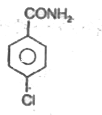The most reactive compound towards formation of cyanohydrin on treatment with KCN followed by acidification is
benzaldehyde
p-nitrobenzaldehyde
phenylacetaldehyde
p-hydroxybenzaldehyde
To determine the most reactive compound towards the formation of cyanohydrin when treated with KCN followed by acidification, we need to analyze the reactivity of the given compounds based on their structure and the influence of substituents on the carbonyl carbon.
1. Identify the Compounds: The compounds given are:
- Option 1: Benzaldehyde
- Option 2: Paranitrobenzaldehyde
- Option 3: Phenylacetaldehyde
- Option 4: A compound with a hydroxyl group and a benzaldehyde group
- Option 5: CO (Carbon monoxide)
- Option 6: CH3 (Methyl group)
2. Understand the Reaction: The reaction involves the nucleophilic attack of the cyanide ion (CN⁻) on the carbonyl carbon of the aldehyde or ketone. The reactivity depends on the electrophilicity of the carbonyl carbon, which is influenced by the substituents attached to it.
3. Analyze Each Compound:
- Benzaldehyde: The carbonyl carbon is moderately electrophilic.
- Paranitrobenzaldehyde: The nitro group (–NO2) is an electron-withdrawing group, which increases the electrophilicity of the carbonyl carbon, making it more reactive towards nucleophiles.
- Phenylacetaldehyde: The presence of the phenyl group (–C6H5) can slightly decrease the electrophilicity of the carbonyl carbon compared to benzaldehyde.
- Compound with Hydroxyl Group: The hydroxyl group (–OH) is an electron-donating group, which decreases the electrophilicity of the carbonyl carbon, making it less reactive.
- CO and CH3: These are not relevant for this reaction as they do not represent carbonyl compounds.
4. Compare Reactivity:
- The presence of the nitro group in paranitrobenzaldehyde significantly increases the electrophilicity of the carbonyl carbon due to its strong electron-withdrawing effect.
- Benzaldehyde has a moderate reactivity, while phenylacetaldehyde is less reactive due to the electron-donating effect of the phenyl group.
- The compound with the hydroxyl group is the least reactive due to the electron-donating nature of the –OH group.
5. Conclusion: Based on the analysis, paranitrobenzaldehyde is the most reactive compound towards the formation of cyanohydrin when treated with KCN followed by acidification.
Final Answer:
The most reactive compound towards the formation of cyanohydrin on treatment with KCN followed by acidification is Paranitrobenzaldehyde.
- Option 1: Benzaldehyde
- Option 2: Paranitrobenzaldehyde
- Option 3: Phenylacetaldehyde
- Option 4: A compound with a hydroxyl group and a benzaldehyde group
- Option 5: CO (Carbon monoxide)
- Option 6: CH3 (Methyl group)
- Benzaldehyde: The carbonyl carbon is moderately electrophilic.
- Paranitrobenzaldehyde: The nitro group (–NO2) is an electron-withdrawing group, which increases the electrophilicity of the carbonyl carbon, making it more reactive towards nucleophiles.
- Phenylacetaldehyde: The presence of the phenyl group (–C6H5) can slightly decrease the electrophilicity of the carbonyl carbon compared to benzaldehyde.
- Compound with Hydroxyl Group: The hydroxyl group (–OH) is an electron-donating group, which decreases the electrophilicity of the carbonyl carbon, making it less reactive.
- CO and CH3: These are not relevant for this reaction as they do not represent carbonyl compounds.
- The presence of the nitro group in paranitrobenzaldehyde significantly increases the electrophilicity of the carbonyl carbon due to its strong electron-withdrawing effect.
- Benzaldehyde has a moderate reactivity, while phenylacetaldehyde is less reactive due to the electron-donating effect of the phenyl group.
- The compound with the hydroxyl group is the least reactive due to the electron-donating nature of the –OH group.
The most reactive compound towards the formation of cyanohydrin on treatment with KCN followed by acidification is Paranitrobenzaldehyde.
Topper's Solved these Questions
- ALDEHYDES AND KETONES Book:FIITJEEChapter:ALDEHYDES AND KETONES Exercise:SOLVED PROBLEMS (OBJECTIVE) COMPREHENSION
Explore 3 Videos
- ALDEHYDES AND KETONES Book:FIITJEEChapter:ALDEHYDES AND KETONES Exercise:Exercise
Explore 5 Videos
- ALDEHYDES AND KETONES Book:FIITJEEChapter:ALDEHYDES AND KETONES Exercise:SOLVED PROBLEMS (SUBJECTIVE)
Explore 17 Videos
- ALCOHOLS, ETHERS AND PHENOLS Book:FIITJEEChapter:ALCOHOLS, ETHERS AND PHENOLS Exercise:SINGLE INTEGER ANSWER TYPE QUESTIONS
Explore 7 Videos
- ALKYL AND ARYL HALIDESBook:FIITJEEChapter:ALKYL AND ARYL HALIDESExercise:NUMERICAL BASED QUESTIONS
Explore 1 Video
Similar Questions
Knowledge Check
The most reactive compound towards cyanohydrin Formation is
APh - CHOB C
C DPh−CH2−CHO
DPh−CH2−CHOThe most reactive compound towards Hofmann bromamide degradation is
A B
B C
C D
D
The most reactive towards SN1 is:
APhCH2CIBPh−CICCH3CHCI(CH3)Dp−NO2−Ph−CH2−CI
The most reactive compound toward reaction with AgNO3 solution is :-
View SolutionThe most reactive compound towards electrophilic substitution reaction is
View SolutionThe most reactive compound towards electrophilic substitution reaction is :-
View SolutionThe compound most reactive towards SN1 reaction is
View SolutionThe compound most suitable for the preparation of cyanohydrin is
View Solution

